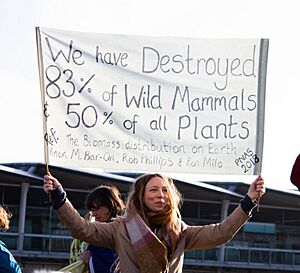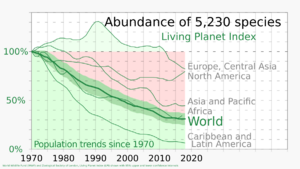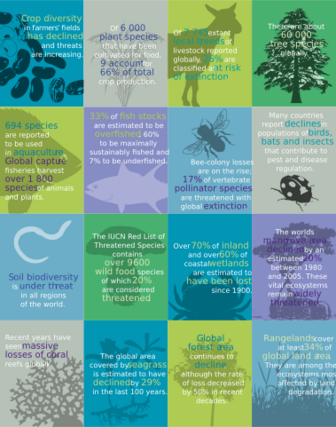Biodiversity loss facts for kids
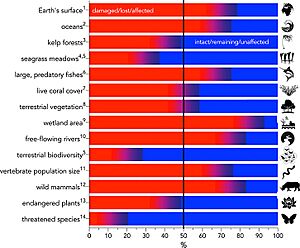
Biodiversity loss happens when plant or animal species disappear completely from Earth (extinction) or when there is a decrease or disappearance of species in a specific area. Biodiversity loss means that there is a reduction in biological diversity in a given area. The decrease can be temporary or permanent. It is temporary if the damage that led to the loss is reversible in time, for example through ecological restoration. If this is not possible, then the decrease is permanent. The cause of most of the biodiversity loss is, generally speaking, human activities that push the planetary boundaries too far. These activities include habitat destruction (for example deforestation) and land use intensification (for example monoculture farming). Further problem areas are air and water pollution (including nutrient pollution), over-exploitation, invasive species and climate change.
Many scientists, along with the Global Assessment Report on Biodiversity and Ecosystem Services, say that the main reason for biodiversity loss is a growing human population because this leads to human overpopulation and excessive consumption. Others disagree, saying that loss of habitat is caused mainly by "the growth of commodities for export" and that population has very little to do with overall consumption. More important are wealth disparities between or within countries.
Climate change is another threat to global biodiversity. For example, coral reefs—which are biodiversity hotspots—will be lost by the year 2100 if global warming continues at the current rate. Still, it is the general habitat destruction (often for expansion of agriculture), not climate change, that is currently the bigger driver of biodiversity loss. Invasive species and other disturbances have become more common in forests in the last several decades. These tend to be directly or indirectly connected to climate change and can cause a deterioration of forest ecosystems.
Groups that care about the environment have been working for many years to stop the decrease in biodiversity. Nowadays, many global policies include activities to stop biodiversity loss. For example, the UN Convention on Biological Diversity aims to prevent biodiversity loss and to conserve wilderness areas. However, a 2020 United Nations Environment Programme report found that most of these efforts had failed to meet their goals. For example, of the 20 biodiversity goals laid out by the Aichi Biodiversity Targets in 2010, only six were "partially achieved" by 2020.
This ongoing global extinction is also called the holocene extinction or sixth mass extinction.
Contents
Global estimates across all species
The current rate of global biodiversity loss is estimated to be 100 to 1000 times higher than the (naturally occurring) background extinction rate, faster than at any other time in human history, and is expected to grow in the upcoming years. The fast-growing extinction trends of various animal groups like mammals, birds, reptiles, amphibians, and fish have led scientists to declare a current biodiversity crisis in both land and ocean ecosystems.
In 2006, many more species were formally classified as rare or endangered or threatened; moreover, scientists have estimated that millions more species are at risk that have not been formally recognized.
Deforestation also plays a large role in biodiversity loss. More than half of the worlds biodiversity is hosted in tropical rainforest. Regions that are subjected to exponential loss of biodiversity are referred to as biodiversity hotspots. Since 1988 the hotspots increased from 10 to 34. Of the total 34 hotspots currently present, 16 of them are in tropical regions (as of 2006). Researchers have noted in 2006 that only 2.3% of the world is covered with biodiversity loss hotspots, and even though only a small percentage of the world is covered in hotspots, it host a large fraction (50%) of vascular plant species.
In 2021, about 28 percent of the 134,400 species assessed using the IUCN Red List criteria are now listed as threatened with extinction—a total of 37,400 species compared to 16,119 threatened species in 2006.
A 2022 study that surveyed more than 3,000 experts found that "global biodiversity loss and its impacts may be greater than previously thought", and estimated that roughly 30% of species "have been globally threatened or driven extinct since the year 1500."
Research published in 2023 found that, out of 70,000 species, about 48% are facing decreasing populations due to human activities, while only 3% are seeing an increase in populations.
Methods to quantify loss
Biologists define biodiversity as the "totality of genes, species and ecosystems of a region". To measure biodiversity loss rates for a particular location, scientists record the species richness and its variation over time in that area. In ecology, local abundance is the relative representation of a species in a particular ecosystem. It is usually measured as the number of individuals found per sample. The ratio of abundance of one species to one or multiple other species living in an ecosystem is called relative species abundance. Both indicators are relevant for computing biodiversity.
There are many different biodiversity indexes. These investigate different scales and time spans. Biodiversity has various scales and subcategories (e.g. phylogenetic diversity, species diversity, genetic diversity, nucleotide diversity).
The question of net loss in confined regions is often a matter of debate.
Observations by type of life
Wildlife in general
An October 2020 analysis by Swiss Re found that one-fifth of all countries are at risk of ecosystem collapse as the result of anthropogenic habitat destruction and increased wildlife loss. If these losses are not reversed, a total ecosystem collapse could ensue.
In 2022, the World Wildlife Fund reported an average population decline of 68% between 1970 and 2016 for 4,400 animal species worldwide, encompassing nearly 21,000 monitored populations.
Terrestrial invertebrates
Insects
Earthworms
Scientists have studied loss of earthworms from several long-term agronomic trials. They found that relative biomass losses of minus 50–100% (with a mean of minus 83 %) match or exceed those reported for other faunal groups. Thus it is clear that earthworms are similarly depleted in the soils of fields used for intensive agriculture. Earthworms play an important role in ecosystem function, helping with biological processing in soil, water, and even greenhouse gas balancing. There are five reasons for the decline of earthworm diversity: "(1) soil degradation and habitat loss, (2) climate change, (3) excessive nutrient and other forms of contamination load, (4) over-exploitation and unsustainable management of soil, and (5) invasive species". Factors like tillage practices and intensive land use decimate the soil and plant roots that earthworms use to create their biomass. This interferes with carbon and nitrogen cycles.
Knowledge of earthworm species diversity is quite limited as not even 50% of them have been described. Sustainable agriculture methods could help prevent earthworm diversity decline, for example reduced tillage. The Secretariat of the Convention on Biological Diversity is trying to take action and promote the restoration and maintenance of the many diverse species of earthworms.
Amphibians
Wild mammals
Birds
Some pesticides, like insecticides, likely play a role in reducing the populations of specific bird species. According to a study funded by BirdLife International, 51 bird species are critically endangered and eight could be classified as extinct or in danger of extinction. Nearly 30% of extinction is due to hunting and trapping for the exotic pet trade. Deforestation, caused by unsustainable logging and agriculture, could be the next extinction driver, because birds lose their habitat and their food.
Plants
Trees
While plants are essential for human survival, they have not received the same attention as the conservation of animals. It is estimated that a third of all land plant species are at risk of extinction and 94% have yet to be evaluated in terms of their conservation status. Plants existing at the lowest trophic level require increased conservation to reduce negative impacts at higher trophic levels.
In 2022, scientists warned that a third of tree species are threatened with extinction. This will significantly alter the world's ecosystems because their carbon, water and nutrient cycles will be affected. Forest areas are degraded due to common factors such as logging, fire, and firewood harvesting. The GTA (global tree assessment) has determined that "17,510 (29.9%) tree species are considered threatened with extinction. In addition, there are 142 tree species recorded as Extinct or Extinct in the Wild."
Possible solutions can be found in some silvicultural methods of forest management that promote tree biodiversity, such as selective logging, thinning or crop tree management, and clear cutting and coppicing. Without solutions, secondary forests recovery in species richness can take 50 years to recover the same amount as the primary forest, or 20 years to recover 80% of species richness.
Flowering plants
Freshwater species
Freshwater ecosystems such as swamps, deltas, and rivers make up 1% of earth's surface. They are important because they are home to approximately one third of vertebrate species. Freshwater species are beginning to decline at twice the rate of species that live on land or in the ocean. This rapid loss has already placed 27% of 29,500 species dependent on fresh water on the IUCN Red List.
Global populations of freshwater fish are collapsing due to water pollution and overfishing. Migratory fish populations have declined by 76% since 1970, and large "megafish" populations have fallen by 94% with 16 species declared extinct in 2020.
Marine species
Marine biodiversity encompasses any living organism that resides in the ocean or in estuaries. By 2018, approximately 240,000 marine species had been documented. But many marine species—estimates range between 178,000 and 10 million oceanic species—remain to be described. It is therefore likely that a number of rare species (not seen for decades in the wild) have already disappeared or are on the brink of extinction, unnoticed.
Human activities have a strong and detrimental influence on marine biodiversity. The main drivers of marine species extinction are habitat loss, pollution, invasive species, and overexploitation. Greater pressure is placed on marine ecosystems near coastal areas because of the human settlements in those areas.
Overexploitation has resulted in the extinction of over 25 marine species. This includes seabirds, marine mammals, algae, and fish. Examples of extinct marine species include Steller's sea cow (Hydrodamalis gigas) and the Caribbean monk seal (Monachus tropicalis). Not all extinctions are because of humans. For example, in the 1930s, the eelgrass limpet (Lottia alveus) became extinct in the Atlantic once the Zostera marina seagrass population declined upon exposure to a disease. The Lottia alveus were greatly impacted because the Zostera marina were their sole habitats.
Causes
The main causes of current biodiversity loss are:
- Habitat loss, fragmentation and degradation; for example habitat fragmentation for commercial and agricultural uses (specifically monoculture farming)
- Land use intensification (and ensuing land loss/habitat loss); a significant factor in loss of ecological services due to direct effects as well as biodiversity loss
- Nutrient pollution and other forms of pollution (air and water pollution)
- Overexploitation and unsustainable use (for example unsustainable fishing methods, overfishing, overconsumption and human overpopulation)
- Invasive species that effectively compete for a niche, replacing indigenous species
- Climate change (e.g. extinction risk from climate change, effects of climate change on plant biodiversity)
Jared Diamond describes an "Evil Quartet" of habitat destruction, overkill, introduced species and secondary extinctions. Edward O. Wilson suggested the acronym HIPPO for the main causes of biodiversity loss: Habitat destruction, Invasive species, Pollution, human over-Population and Over-harvesting.
Habitat destruction
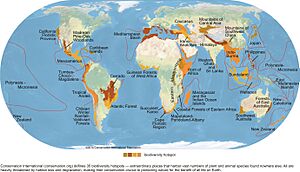

Habitat destruction is when a habitat is no longer able to support the plants, animals, or other organisms that live in it. When this happens, the organisms could die. Some might move to other places.
Habitat loss can happen naturally. Wildfires can destroy plants that animals need to live in or to eat. Lava flows from volcanoes can do the same thing.Urban growth and habitat fragmentation
The direct effects of urban growth on habitat loss are well understood: building construction often results in habitat destruction and fragmentation. This leads to selection for species that are adapted to urban environments. Small habitat patches cannot support the level of genetic or taxonomic diversity they formerly could while some more sensitive species may become locally extinct. Species abundance populations are reduced due to the reduced fragmented area of habitat. This causes an increase of species isolation and forces species toward edge habitats and to adapt to foraging elsewhere.
Infrastructure development in Key Biodiversity Areas (KBA) is a major driver of biodiversity loss, with infrastructure present in roughly 80% of KBAs. Infrastructure development leads to conversion and fragmentation of natural habitat, pollution and disturbance. There can also be direct harm to animals through collisions with vehicles and structures. This can have impacts beyond the infrastructure site.
Land use intensification
Humans are changing the uses of land in various ways, and each can lead to habitat destruction and biodiversity loss. The 2019 Global Assessment Report on Biodiversity and Ecosystem Services found that industrial agriculture is the primary driver of biodiversity collapse. The UN's Global Biodiversity Outlook 2014 estimated that 70% of the projected loss of terrestrial biodiversity is caused by agriculture use. According to a 2005 publication, "Cultivated systems [...] cover 24% of Earth's surface". The publication defined cultivated areas as "areas in which at least 30% of the landscape is in croplands, shifting cultivation, confined livestock production, or freshwater aquaculture in any particular year".
More than 17,000 species are at risk of losing habitat by 2050 as agriculture continues to expand to meet future food needs (as of 2020). A global shift toward largely plant-based diets would free up land to allow for the restoration of ecosystems and biodiversity. In the 2010s over 80% of all global farmland was used to rear animals.
As of 2022, 44% of Earth's land area required conservation attention, which may include declaring protected areas and following land-use policies.
Nutrient pollution and other forms of pollution
Air pollution
Air pollution adversely affects biodiversity. Pollutants are emitted into the atmosphere by the burning of fossil fuels and biomass, for example. Industrial and agricultural activity releases the pollutants sulfur dioxide and nitrogen oxides. Once sulfur dioxide and nitrogen oxide are introduced into the atmosphere, they can react with cloud droplets (cloud condensation nuclei), raindrops, or snowflakes, forming sulfuric acid and nitric acid. With the interaction between water droplets and sulfuric and nitric acids, wet deposition occurs and creates acid rain.
A 2009 review studied four air pollutants (sulfur, nitrogen, ozone, and mercury) and several types of ecosystems. Air pollution affects the functioning and biodiversity of terrestrial as well as aquatic ecosystems. For example, "air pollution causes or contributes to acidification of lakes, eutrophication of estuaries and coastal waters, and mercury bioaccumulation in aquatic food webs".
Noise pollution
Noise generated by traffic, ships, vehicles, and aircraft can affect the survivability of wildlife species and can reach undisturbed habitats. Noise pollution is common in marine ecosystems, affecting at least 55 marine species. One study found that as seismic noises and naval sonar increases in marine ecosystems, cetacean diversity decreases (including whales and dolphins). Multiple studies have found that fewer fishes, such as cod, haddock, rockfish, herring, sand seal, and blue whiting, have been spotted in areas with seismic noises, with catch rates declining by 40–80%.
Noise pollution has also altered avian communities and diversity. Noise can reduce reproductive success, minimize nesting areas, increase stress response, and reduce species abundance. Noise pollution can alter the distribution and abundance of prey species, which can then impact predator populations.
Pollution from fossil fuel extraction
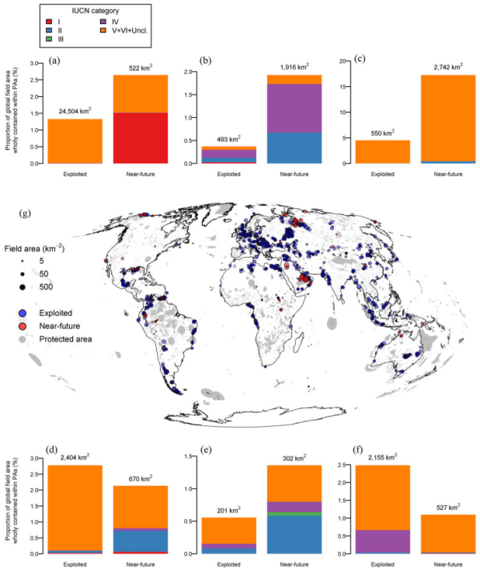
Fossil fuel extraction and associated oil and gas pipelines have major impacts on the biodiversity of many biomes due to land conversion, habitat loss and degradation, and pollution. An example is the Western Amazon region. Exploitation of fossil fuels there has had significant impacts on biodiversity. As of 2018, many of the protected areas with rich biodiversity were in areas containing unexploited fossil fuel reserves worth between $3 and $15 trillion. The protected areas may be under threat in future.
Overexploitation
Continued overexploitation can lead to the destruction of the resource, as it will be unable to replenish. The term applies to natural resources such as water aquifers, grazing pastures and forests, wild medicinal plants, fish stocks and other wildlife.
Overfishing
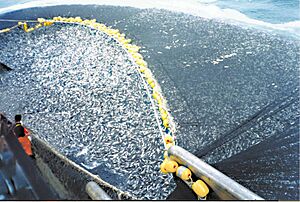

A 2019 Intergovernmental Science-Policy Platform on Biodiversity and Ecosystem Services report found that overfishing is the main driver of mass species extinction in oceans. Overfishing has reduced fish and marine mammal biomass by 60% since the 1800s. It is currently pushing over one-third of sharks and rays toward extinction.
Many commercial fishes have been overharvested: a 2020 FAO report classified as overfished 34% of the fish stocks of the world's marine fisheries. By 2020, global fish populations had declined 38% since 1970.
Many regulatory measures are available for controlling overfishing. These include fishing quotas, bag limits, licensing, closed seasons, size limits, and the creation of marine reserves and other marine protected areas.
Human overpopulation and overconsumption
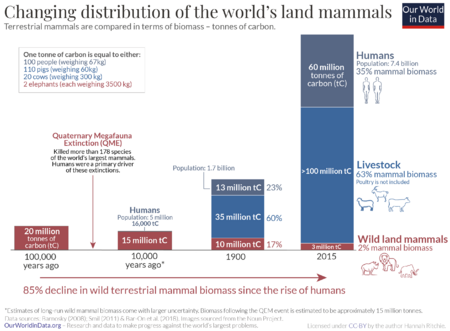
The world's population numbered nearly 7.6 billion as of mid-2017 and is forecast to peak toward the end of the 21st century at 10–12 billion people. Scholars have argued that population size and growth, along with overconsumption, are significant factors in biodiversity loss and soil degradation. Review articles, including the 2019 IPBES report, have also noted that human population growth and overconsumption are significant drivers of species decline. A 2022 study warned that conservation efforts will continue to fail if the primary drivers of biodiversity loss continue to be ignored, including population size and growth.
Other scientists have criticized the assertion that population growth is a key driver for biodiversity loss. They argue that the main driver is the loss of habitat, caused by "the growth of commodities for export, particularly soybean and oil-palm, primarily for livestock feed or biofuel consumption in higher income economies." Because of the wealth disparities between countries, there is a negative correlation between a country's total population and its per capita footprint. On the other hand, the correlation between a country's GDP and its footprint is strong. The study argues that population as a metric is unhelpful and counterproductive for tackling environmental challenges.
Invasive species
The term invasive is poorly defined and often very subjective. The European Union defines invasive alien species as those outside their natural distribution area that threaten biological diversity. Biotic invasion is considered one of the five top drivers of global biodiversity loss and is increasing because of tourism and globalization. This may be particularly true in poorly regulated fresh water systems, though quarantines and ballast water rules have improved the situation.
Invasive species may drive local native species to extinction via competitive exclusion, niche displacement, or hybridisation with related native species. Therefore, alien invasions may result in extensive changes in the structure, composition and global distribution of the biota at sites of introduction. This leads to the homogenisation of the world's fauna and flora and biodiversity loss.
Climate change
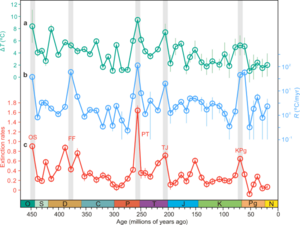
Climate change is another threat to global biodiversity. But habitat destruction, e.g., for the expansion of agriculture, is currently a more significant driver of biodiversity loss.
A 2021 collaborative report by scientists from the IPBES and the IPCC found that biodiversity loss and climate change must be addressed simultaneously, as they are inextricably linked and have similar effects on human well-being. In 2022, Frans Timmermans, Vice-President of the European Commission, said that people are less aware of the threat of biodiversity loss than they are of the threat of climate change.
The interaction between climate change and invasive species is complex and not easy to assess. Climate change is likely to favour some invasive species and harm others, but few authors have identified specific consequences of climate change for invasive species.
Invasive species and other disturbances have become more common in forests in the last several decades. These tend to be directly or indirectly connected to climate change and have negative consequences for forest ecosystems.
Extinction risks
Impacts
On ecosystems
Biodiversity loss has bad effects on the functioning of ecosystems. This in turn affects humans, because affected ecosystems can no longer provide the same quality of ecosystem services, such as crop pollination, cleaning air and water, decomposing waste, and providing forest products as well as areas for recreation and tourism.
Two key statements of a 2012 comprehensive review of the previous 20 years of research include:
- "There is now unequivocal evidence that biodiversity loss reduces the efficiency by which ecological communities capture biologically essential resources, produce biomass, decompose and recycle biologically essential nutrients"; and
- "Impacts of diversity loss on ecological processes might be sufficiently large to rival the impacts of many other global drivers of environmental change"
Permanent global species loss (extinction) is a more dramatic phenomenon than regional changes in species composition. But even minor changes from a healthy stable state can have a dramatic influence on the food web and the food chain, because reductions in one species can adversely affect the entire chain (coextinction). This can lead to an overall reduction in biodiversity, unless alternative stable states of the ecosystem are possible.
For example, a study on grasslands used manipulated grassland plant diversity and found that ecosystems with higher biodiversity show more resistance of their productivity to climate extremes.
On food and agriculture
In 2019, the UN's Food and Agriculture Organization (FAO) produced its first report on The State of the World's Biodiversity for Food and Agriculture. It warned that "Many key components of biodiversity for food and agriculture at genetic, species and ecosystem levels are in decline."
The report also said, "Many of the drivers that have negative impacts on BFA (biodiversity for food and agriculture), including overexploitation, overharvesting, pollution, overuse of external inputs, and changes in land and water management, are at least partially caused by inappropriate agricultural practices" and "transition to intensive production of a reduced number of species, breeds and varieties, remain major drivers of loss of BFA and ecosystem services."
To reduce biodiversity loss related to agricultural practices, FAO encourages the use of "biodiversity-friendly management practices in crop and livestock production, forestry, fisheries and aquaculture".
On health and medicines
The WHO has analyzed how biodiversity and human health are connected: "Biodiversity and human health, and the respective policies and activities, are interlinked in various ways. First, biodiversity gives rise to health benefits. For example, the variety of species and genotypes provide nutrients and medicines." The ongoing drivers and effects of biodiversity loss has the potential to lead to future zoonotic disease outbreaks like the COVID-19 pandemic.
Medicinal and aromatic plants are widely used in traditional medicine as well as in cosmetic and food industries. The WHO estimated in 2015 that about "60,000 species are used for their medicinal, nutritional and aromatic properties". There is a global trade in plants for medicinal purposes.
Biodiversity contributes to the development of pharmaceuticals. A significant proportion of medicines are derived from natural products, either directly or indirectly. Many of these natural products come from marine ecosystems. However, unregulated and inappropriate over-harvesting (bioprospecting) could potentially lead to overexploitation, ecosystem degradation and loss of biodiversity. Users and traders harvest plants for traditional medicine either by planting them or by collecting them in the wild. In both cases, sustainable medicinal resource management is important.
Proposed solutions
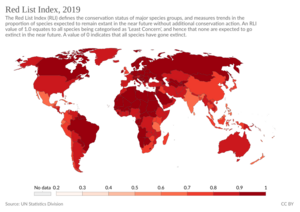
Scientists are investigating what can be done to address biodiversity loss and climate change together. For both of these crises, there is a need to "conserve enough nature and in the right places". A 2020 study found that "beyond the 15% land area currently protected, 35% of land area is needed to conserve additional sites of particular importance for biodiversity and stabilize the climate."
Additional measures for protecting biodiversity, beyond just environmental protection, are important. Such measures include addressing drivers of land use change, increasing efficiency in agriculture, and reducing the need for animal agriculture. The latter could be achieved by increasing the shares of plant-based diets.
Convention on Biological Diversity
Many governments have conserved portions of their territories under the Convention on Biological Diversity (CBD), a multilateral treaty signed in 1992–3. The 20 Aichi Biodiversity Targets are part of the CBD's Strategic Plan 2011–2020 and were published in 2010. Aichi Target Number 11 aimed to protect 17% of terrestrial and inland water areas and 10% of coastal and marine areas by 2020 .
Of the 20 biodiversity goals laid out by the Aichi Biodiversity Targets in 2010, only six were partially achieved by 2020. The 2020 CBD report highlighted that if the status quo does not change, biodiversity will continue to decline due to "currently unsustainable patterns of production and consumption, population growth and technological developments". The report also singled out Australia, Brazil, Cameroon and the Galapagos Islands (Ecuador) for having had one of its animals lost to extinction in the previous ten years.
Following this, the leaders of 64 nations and the European Union pledged to halt environmental degradation and restore the natural world. The pledge was not signed by leaders from some of the world's biggest polluters, namely China, India, Russia, Brazil and the United States. Some experts contend that the United States' refusal to ratify the Convention on Biological Diversity is harming global efforts to halt the extinction crisis.
Scientists say that even if the targets for 2020 had been met, no substantial reduction of extinction rates would likely have resulted. Others have raised concerns that the Convention on Biological Diversity does not go far enough, and argue the goal should be zero extinctions by 2050, along with cutting the impact of unsustainable food production on nature by half. That the targets are not legally binding has also been subject to criticism.
In December 2022, every country except the United States and the Holy See signed onto the Kunming-Montreal Global Biodiversity Framework at the 2022 United Nations Biodiversity Conference. This framework calls for protecting 30% of land and oceans by 2030 (30 by 30). It also has 22 other targets intended to reduce biodiversity loss. At the time of signing the agreement, only 17% of land territory and 10% of ocean territory were protected. The agreement includes protecting the rights of Indigenous peoples and changing the current subsidy policy to one better for biodiversity protection, but it takes a step backward in protecting species from extinction in comparison to the Aichi Targets. Critics said the agreement does not go far enough to protect biodiversity, and that the process was rushed.
Other international and national action
In 2019 the Intergovernmental Science-Policy Platform on Biodiversity and Ecosystem Services (IPBES) published the Global Assessment Report on Biodiversity and Ecosystem Services. This report said that up to a million plant and animal species are facing extinction because of human activity. The IPBES is an international organization that has a similar role to the Intergovernmental Panel on Climate Change (IPCC), except that it focuses on biodiversity and ecosystem services, not climate change.
The United Nations' Sustainable Development Goal 15 (SDG 15), "Life on Land", includes biodiversity targets. Its fifth target is: "Take urgent and significant action to reduce the degradation of natural habitats, halt the loss of biodiversity and, by 2020, protect and prevent the extinction of threatened species." This target has one indicator: the Red List Index.
Nearly three-quarters of bird species, two thirds of mammals and more than half of hard corals have been recorded at World Heritage Sites, even though they cover less than 1% of the planet. Countries with World Heritage Sites can include them in their national biodiversity strategies and action plans.
See also
- Biodiversity offsetting
- Defaunation
- Ecological collapse
- Ecological extinction
- Effects of climate change on biomes
- Effects of climate change on plant biodiversity
- Species reintroduction
- Triple planetary crisis



